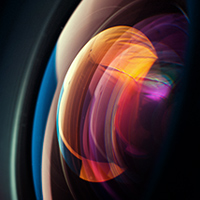Abstract
The favorable laser properties of Yb-doped earth alkaline fluorapalite crystals (FAP) have been demonstrated [1]. Fluoride phosphate (FP) glasses are a kind of amorphous analogon to these both fluoride and phosphate anions containing crystals. It could be shown that Yb-doped FP-glasses have the potential for cheap diode pumped cw-lasers acting at wavelength around 1.04 μm at room temperature (2). In first experiments using laser diodes emitting at 968 nm (longitudinal pumping geometry, hemispheric resonator with an output mirror of r = −5 cm radius of curvature, T = 2 %) and not optimized FP-glasses we achieved maximum output powers Pout of about 145 mW and absorbed pump powers at thresholds Pthr,abs of about 185 mW. Recently, experiments with optimized glasses demonstrated improved laser performance (up to Pout of about 220 mW;Pthr,abs ~106 mW) [3]. Similar to DeLoach et al. [4] we trace the surprisingly good laser parameters to the special energy level structure of the 2F7/2:Yb ground manifold in the mentioned materials. The laser transition terminates at an electronic Yb-level (about 600 cm−1 above the ground state) interacting with the local vibrational modes of localized Yb-O bonds. The huge variety of FP-glass compositions provides a useful tool to tailor the local structure at the site of the Yb-ion and in this way the electron-phonon interactions itself. To optimize the host glass matrix we used the following simple structural model: Yb3− ions are mostly six co-ordinated in the investigated FP-glasses. Three PO43− (phosphate)-tetra-hedra form a cluster with D3-symmetry about the Yb ion. So-called v4-vibrations of the surrounding phosphate groups (~ 570 cm−1) can interact with the electronic Yb-transition. The addition of heavy ions (e.g. Ba) and other tetrahedral groups (e.g. SO42−) to batch composition: 95 mol-% (AlF3 earth alkaline fluorides) - 5 mol-% Sr(PO3)2 strongly improves the laser properties. This can be explained by formation of [Yb(PO4)3]-clusters which are nearly isolated from the mainparts of the network. Because of the inhomogeneous site variation in glasses no detailed structures in the absorption spectra could be observed even at low temperatures. Nevertheless, the corresponding terminal laser level (~ 600 cm−1 at high pump power densities) supports the assumption of efficient electron-phonon coupling. The intensity borrowing effect by this mechanism can be understood in terms of a electron-vibrational coupling constant [4], but the direct influence on the laser properties itself is not yet understood. We believe that the electron-phonon coupling efficiently depopulates the terminal laser level too. In conclusion, efficient cw-laser action in optimized FP-glasses can be traced to nearly isolated [Yb(PO4)3]-clusters with effective electron-phonon coupling.
© 1996 IEEE
PDF ArticleMore Like This
T. Danger, E. Mix, E. Heumann, G. Huber, D. Ehrt, and W. Seeber
YL6 Advanced Solid State Lasers (ASSL) 1996
U. Griebner, R. Koch, H Schönnagel, D. Ehrt, and W. Seeber
CML4 The European Conference on Lasers and Electro-Optics (CLEO/Europe) 1996
T. Danger, G. Huber, K. Petermann, and W. Seeber
CS12 Advanced Solid State Lasers (ASSL) 1998

